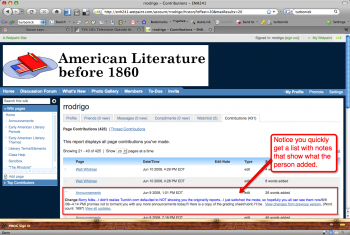TVS 101: Teaching an Online Intro to Television Course
Shelley Rodrigo / Mesa Community College

This article is second in a three part series that includes:
- TVS 101: Television Outside the Box
I discuss what I’m considering to include as part of an introduction to a television course. Look at this Flow installment published on 06/09/08. - TVS 101: “Tracking the New Show” Course Project
I’ll share the major course project and discuss how it balances student interest with course content requirements. Look for this Flow installment on 09/05/08.
In this article I discuss how I am designing the Introduction to Television course I will be teaching online this Fall 2008 semester.
Reality Checks (or premises to consider as I build this course):
- This is the first time that I’m teaching this class, and I do not proclaim to be a television studies person (definitely more film and computer media studies). I look forward to learning about the material with the students; in that vein, I’ll be doing all the assignments with them!
- I believe in social-constructivist learning philosophy; therefore, I want to construct the course in a manner that allows students to have input into what, how, and why we are studying various ideas and concepts.
- There are 19 course outcomes that students are supposed to be able to achieve at the end of the course. These do not perfectly align with the textbook I have selected; therefore, I have to somehow mesh the textbook material with some outcomes as well as find supplementary material to support other outcomes.
- I believe it is unethical to require students to have watched something that is not easily available (i.e, that they can view online for free or can easily be rented at a local video store). However, I will also admit the online course is cross-listed with a Monday night course which will allow online students an opportunity to come to class for specific viewings.
One of the main reasons I decided to offer an introduction to TV course online was because of the proliferation of television shows that are freely and legally available to watch over the web. Besides the specific show’s official website (many of which provide the most current episode) and other network websites, there are the following types of sites that also stream different shows:
and
Obviously, the fact that so many shows, both classic and contemporary, are being released on DVD and are therefore easily available through Netflix, also helps. Like I mentioned in “Television Outside the Box,” I also think that the sprawl of television narratives, especially in various forms on the web, makes teaching this course online a little bit easier and more relevant.
The course will be offered using a Wetpaint Wiki. Wikis are websites that allow readers to contribute to the content (like Wikipedia). Wetpaint Wikis also include discussion boards for each wiki page, and track individual contributions to the different pages, which is extremely helpful when grading student contributions.

As you can see from the course wiki site, there is not much up yet (obviously I’ll be adding a little bit more prior to the course starting at the end of August). Instead of developing an entire set of materials to then pour into my students, they will help me construct the website as we work through the course. During the first week students will rank their interest in the topics of the different textbook chapters, and I will then assign each student a chapter. Students will then become “experts” on the chapter and then help construct the wiki page and course activities associated with it. Specifically students will be asked to develop the following “packet” for their specific chapter:
- chapter summary and outline;
- 3-4 discussion questions (questions must have participants engage both the reading material and example television shows and episodes);
- reading quiz (multiple choice, true/false, matching, and fill in the blank);
- brief discussion of 3-4 television shows, preferably specific episodes, that function as examples of the chapter content (at least one must be freely available on the internet and at least one can not be listed in the chapter); and
- associate chapter content with relevant course outcomes.
I will develop the first chapter packet After I synchronously “meet” with students to discuss their packets, the class will work through each chapter on a weekly basis (take the reading quiz and participate in an asynchronous discussion board).
Once we have developed the course content for the textbook chapters, we’ll do the same type of assignment for the course outcomes. Students will rank their preference for course outcomes, I will assign individual outcomes to each student, and then they will build another “packet” of information, including:
- detailed description of what the outcome means and why it is important to understand in television studies;
- annotated bibliographies of 3-4 readings that help discuss, explain, or explore the outcome (one reading must come from Flow and another must be a scholarly or peer-reviewed source and come from the library databases); and
- brief discussion of 3-4 television shows, preferably specific episodes, that function as examples of the outcomes (at least one must be freely available on the internet).
Like with the textbook chapters, students will each become an “expert” on an individual outcome. Instead of working through each outcome on a weekly basis (there are not enough weeks in the semester and the outcome “packets” will not be fully developed until the seventh week of a sixteen week semester), students will then work through most of the outcomes while building their “Tracking the New Show” course project (which I will expand upon in the final article within this series). And as students need help making connections between what they are consuming with their new show and various course outcomes, they will be able to seek out the assistance of the course “expert” for each outcome.
I’ve taught a few different courses in a similar manner where students help construct the course content. This past summer I had one of my students mention that it must be “easy” teaching online because the students are doing all of the “work.” However, I think this goes back to asking ourselves what do we want students to remember from our course five years from now. I know these students will remember what they became “experts” on, a chapter, an outcome, and a new television show. Is that being a “slacker” teacher, or a savvy one?
Image Credits:
1. Introduction to Television Arts
2. hulu.com
3. joost.com
4. Sample Wetpaint Wiki
Please feel free to comment.


Shelley,
Interesting approach to teaching this sort of introductory class, I’m curious as to how it works with it all being online and all!
Your comment that if students have questions about the connections between course materials and the course outcomes they can talk to the “expert” intrigued me. In my own discussion sections I find that is what I have to explain most often– do you anticipate that these students will understand the connections the way that you hope or do you think you’ll need to weigh in during those types of discussions more often than not?
Laura,
By “meeting” with them to discuss their “expertise” I’ll be weighing in to help make those connections. What should also help tremendously is the final project (which will be my last posting), where they will connect the outcomes to a program of their choice that they are following. Which means “experts” should really “see” their area in their program and then help other students make connections. By giving the students the choice to select their own program they’ll be motivated to “know” about it.
Is that making sense?
Shelley